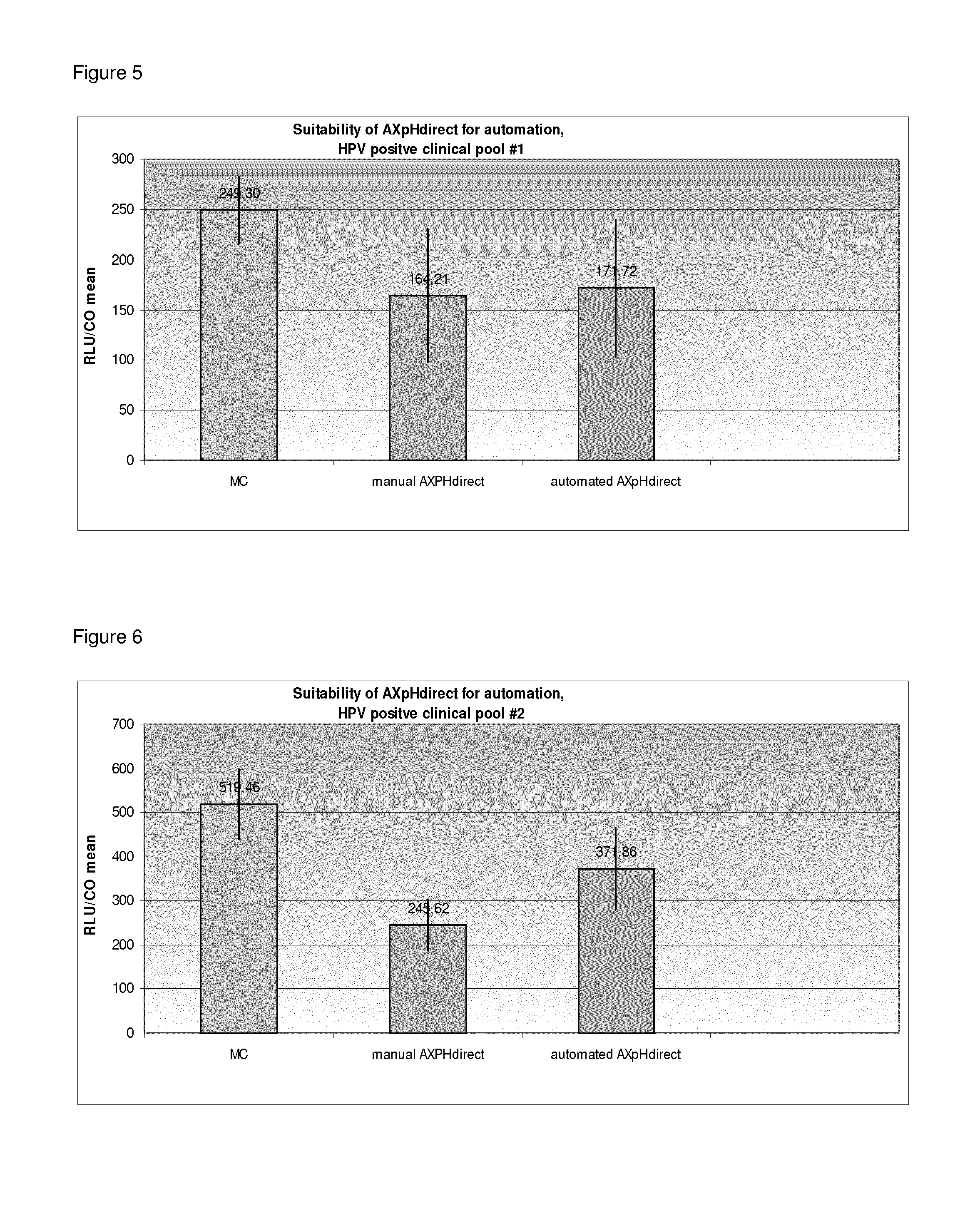Method of determining the presence or absence of a target nucleic acid in a cell sample
a nucleic acid and cell technology, applied in the field of detecting the presence or absence of a target nucleic acid in a cell, can solve the problem of significant reduction of the necessary preparation steps, and achieve the effects of rapid preparation of cell samples, reliable, rapid and suitable for automation
- Summary
- Abstract
- Description
- Claims
- Application Information
AI Technical Summary
Benefits of technology
Problems solved by technology
Method used
Image
Examples
example 1
Comparison of Manual AXpH-Direct and Manual Conversion
1.1) Reference: Sample Preparation by Manual Conversion (MC)
[0329]In case of MC, which is the standard prior art method, sample preparation was performed as follows: Samples from a HPV negative clinical pool and a HPV positive clinical pool, both in SUREPATH® medium (see below), were used. SUREPATH® Post-gradient samples were obtained by density gradient centrifugation and the respectively obtained samples were further processed as described in the following.
[0330]First, the samples were vortexed thoroughly. 2.8 ml of each sample were transferred to a 15 ml centrifuge tube and centrifuged for 10 min at 800 g. After centrifugation, the supernatant was decanted and the centrifuge tube (with the opening downwards) was dabbed on a cloth 3 times. 200 μl of Specimen Transport Medium (STM, Digene—comprising a chaotropic agent) were added to each pellet, i.e. sample, and vortexed for 15 sec at maximum speed until the complete pellet was ...
example 2
Suitability of AXpH-Direct for Automation
[0341]In Example 2, the following samples were processed:
1) from a HPV negative clinical Pool in SUREPATH® medium (RLU / CO approx. 0.2),
2) SiHa cells in SUREPATH® medium (HPV positive; 1×105 cells / ml),
3) from a HPV positive clinical Pool 1 in SUREPATH® medium (RLU / CO approx. 186.4) and
4) from a HPV positive clinical Pool 2 in SUREPATH® medium (RLU / CO approx. 530)
1.1) Reference: Manual Conversion (MC)
[0342]See Example 1 for the manual conversion (MC) protocol.
1.2) Manual AXpH-Direct Method
[0343]First, the samples were vortexed thoroughly. 2.8 ml of each sample, i.e. 1.4 ml of the initial sample mixed with 1.4 ml of SUREPATH® medium were transferred to a 5 ml PP-Tube. 50 μl of bead suspension I (see Example 1) were added. The tubes were locked with caps, cautiously inverted 10 times and vortexed for 30 sec. The samples were then incubated for 5 min at room temperature. After incubation, the samples were placed on a magnet in order to separate th...
example 3
Suitability of the AXpH-Direct Method for PRESERVCYT® and SUREPATH® Samples
[0348]The following samples were processed:[0349]1. A HPV positive cell culture (SiHa cells) in PRESERVCYT® (PC) medium;[0350]2. A HPV positive cell culture (SiHa cells) in SUREPATH® (SP) medium[0351]3. A positive clinical sample pool in PRESERVCYT® (PC) medium[0352]4. A positive clinical sample pool in SUREPATH® (SP) medium[0353]5. A negative clinical sample pool in PRESERVCYT® (PC) medium[0354]6. A negative clinical sample pool in SUREPATH® (SP) medium
1.1) Reference: Manual Conversion (MC)
[0355]All samples 1 to 6 were processed with the MC protocol. See Example 1 1.1. for sample preparation.
1.2) Manual AXpH-Direct Method (Invention)
[0356]Samples 1, 3, 4 and 5 were processed with this protocol. Here, the protocol described in Example 8 was followed, however, manually processing the PEI modified beads instead of using a robotic system.
1.3) Automated AXpH-Direct Method (QIASYMPHONY—Invention)
[0357]Samples 2, 4...
PUM
| Property | Measurement | Unit |
|---|---|---|
| Force | aaaaa | aaaaa |
| Force | aaaaa | aaaaa |
| Size | aaaaa | aaaaa |
Abstract
Description
Claims
Application Information
 Login to View More
Login to View More - R&D
- Intellectual Property
- Life Sciences
- Materials
- Tech Scout
- Unparalleled Data Quality
- Higher Quality Content
- 60% Fewer Hallucinations
Browse by: Latest US Patents, China's latest patents, Technical Efficacy Thesaurus, Application Domain, Technology Topic, Popular Technical Reports.
© 2025 PatSnap. All rights reserved.Legal|Privacy policy|Modern Slavery Act Transparency Statement|Sitemap|About US| Contact US: help@patsnap.com



